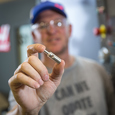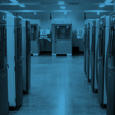
Digital manufacturing and other smart technologies promise to transform the maritime sector – but new expertise and skilled personnel are needed first, according to an exclusive survey by the IMarEST and Protolabs.
There is a wealth of opportunity on the horizon. Automation and digitalisation promise to transform the maritime industry, boosting efficiency and ensuring it continues to play its central role in global freight, transport, energy and countless other sectors long into the future.
Getting there will be far from easy, however, and one major issue threatens to prevent progress – a lack of expertise and skilled personnel. Alongside decarbonisation, the skills gap was identified as the main challenge facing the industry by two-thirds (65%) of respondents in a new survey by the IMarEST and rapid manufacturing specialist Protolabs.
Looking at key innovations, the value they add to the industry and the potential barriers to adoption, the survey of 255 IMarEST members included marine professionals from all levels – naval architects and senior engineers to lieutenant-commanders and consultants, and many more between.

Despite the diversity of job roles, the skills issue was the major concern for most respondents. A lack of expertise was also identified as the greatest challenge facing maritime’s adoption of digital manufacturing techniques, picked by more than half (53.8%) of all those who took part.
“Skilled manpower is still the key manufacturing ‘technology’,” said one respondent – but with limited availability, it seems to be holding back the industry.
“Without proper training at all levels then there will be no future in the UK,” another said. “There are opportunities for companies who train and develop their staff – something currently lacking.”
Conservative mindsets amongst decision makers, mentioned by several respondents as a barrier to the adoption of digital manufacturing techniques, could explain some of the reticence to develop workers’ capabilities and enable them to spearhead digitalisation in their organisations.
After the lack of expertise, equipment cost was the second biggest challenge (picked by 44.6%) and the third was lack of training (39.8%). Lack of awareness (38.3%), time to adopt (37.1%) and not meeting technical or performance specifications (33.1%) were other major challenges. Availability of digital manufacturing techniques was seen as the least significant issue, picked by less than quarter (24.3%) of respondents.
Slow adoption
With such significant hurdles in the way, the modernisation of manufacturing technologies and techniques is often painfully slow. A lack of automation persists in many businesses, with two-fifths (40.7%) of respondents saying that none of their manufacturing services are automated. Only 7.7% said more than half is automated.
“There is a lack of adoption of new technology, especially in the shipping sector. Conditions onboard ship or offshore installation have not really changed for years, and rely upon shoreside support,” one respondent said.
CNC machining is the most important manufacturing technology in the maritime sector, the survey found, selected by two-thirds (67.1%) of those who took part. Robotic manufacturing was a close second on 61.5%, while 3D printing and injection moulding were seen as less important, selected by 32.1% and 29.7% respectively.
When asked about the key manufacturing technologies currently being used in the sector, welding was mentioned by several respondents, along with other conventional methods such as casting, rolling and forging.
A large proportion of respondents (44.1%) said that none of their manufacturing was done in-house, while another quarter (24.9%) said less than 25% was done in-house. A very small number (7.4%) said more than 75% was done in-house.

Challenges and opportunities
As with automation and digital manufacturing, decarbonisation is both a challenge and an opportunity for maritime organisations. Done right, it can help protect marine environments, prevent harmful emissions into the atmosphere, and ultimately create a more sustainable and efficient industry. The industry is huge, however – according to the International Chamber of Shipping, the total value of the annual world shipping trade alone was more than $14 trillion in 2019, making widespread change slow and expensive. Many alternative fuels or electrification techniques are still relatively unproven or difficult to rapidly expand, compounding the issue.
As such, decarbonisation was the joint biggest challenge facing the industry, selected by two-thirds of respondents (65%) alongside the lack of expertise and skilled personnel. Sustainability followed (45.3%), then technology adoption (40.2%). The fuel supply chain was selected by 30.3%, while 26.8% said the main challenge was the materials supply chain.
Thankfully, respondents saw a lot to look forward to in the maritime industry. While far from straightforward, decarbonisation was seen as major future opportunity. Technology such as alternative fuels, low-carbon techniques such as wind-assisted propulsion, air lubrication to reduce hull resistance, electric propulsion, solar power, and even discrete nuclear power plants onboard merchant marine vessels were seen as potential solutions in the race to reduce emissions. New renewable technologies, such as tidal energy or floating wind farms, will also rely on maritime techniques and expertise.

Robotic and additive manufacturing could be transformative for ships at sea, cutting the price for replacement parts and helping ship staff minimise downtime. “3D printing technology will play a big role,” said one person. “There will be a lot of opportunities in the near future when it comes to manufacturing of marine components.”
Autonomy will also boost efficiency for worldwide freight, with autonomous craft and drones offering streamlined logistics. Uncrewed transport could follow ‘low-manned’ solutions, helping keep seafarers out of potentially dangerous situations, while remote reading of health and monitoring systems – enabled by sensor networks and other technologies – will enable monitoring and reconfiguration of systems from a distance.
Clearly, there is a lot to look forward to on the horizon – but organisations need to take the initiative and train their workers on cutting-edge technology to ensure the industry gets there.

Thank you for downloading our guide on digital manufacturing for defence, marine and maritime. If you have any issues getting your guide, click here to download.






